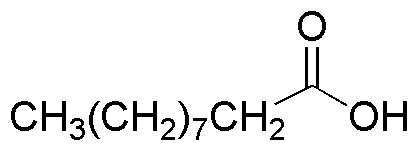Decanoic acid is widely utilized in research focused on:
- Food Industry: Used as a flavoring agent and preservative in various food products, enhancing taste while providing antimicrobial properties.
- Cosmetics and Personal Care: Incorporated in formulations for creams and lotions due to its emollient properties, helping to moisturize and soften the skin.
- Pharmaceuticals: Serves as a medium-chain fatty acid in drug formulations, improving solubility and bioavailability of certain medications.
- Biofuels: Acts as a potential feedstock for biodiesel production, contributing to renewable energy solutions and reducing reliance on fossil fuels.
- Industrial Applications: Used in the production of surfactants and detergents, providing effective cleaning properties while being biodegradable.
General Information
Properties
Safety and Regulations
Applications
Decanoic acid is widely utilized in research focused on:
- Food Industry: Used as a flavoring agent and preservative in various food products, enhancing taste while providing antimicrobial properties.
- Cosmetics and Personal Care: Incorporated in formulations for creams and lotions due to its emollient properties, helping to moisturize and soften the skin.
- Pharmaceuticals: Serves as a medium-chain fatty acid in drug formulations, improving solubility and bioavailability of certain medications.
- Biofuels: Acts as a potential feedstock for biodiesel production, contributing to renewable energy solutions and reducing reliance on fossil fuels.
- Industrial Applications: Used in the production of surfactants and detergents, providing effective cleaning properties while being biodegradable.
Documents
Safety Data Sheets (SDS)
The SDS provides comprehensive safety information on handling, storage, and disposal of the product.
Product Specification (PS)
The PS provides a comprehensive breakdown of the product’s properties, including chemical composition, physical state, purity, and storage requirements. It also details acceptable quality ranges and the product's intended applications.
Certificates of Analysis (COA)
Search for Certificates of Analysis (COA) by entering the products Lot Number. Lot and Batch Numbers can be found on a product’s label following the words ‘Lot’ or ‘Batch’.
*Catalog Number
*Lot Number
Certificates Of Origin (COO)
This COO confirms the country where the product was manufactured, and also details the materials and components used in it and whether it is derived from natural, synthetic, or other specific sources. This certificate may be required for customs, trade, and regulatory compliance.
*Catalog Number
*Lot Number
Safety Data Sheets (SDS)
The SDS provides comprehensive safety information on handling, storage, and disposal of the product.
DownloadProduct Specification (PS)
The PS provides a comprehensive breakdown of the product’s properties, including chemical composition, physical state, purity, and storage requirements. It also details acceptable quality ranges and the product's intended applications.
DownloadCertificates of Analysis (COA)
Search for Certificates of Analysis (COA) by entering the products Lot Number. Lot and Batch Numbers can be found on a product’s label following the words ‘Lot’ or ‘Batch’.
*Catalog Number
*Lot Number
Certificates Of Origin (COO)
This COO confirms the country where the product was manufactured, and also details the materials and components used in it and whether it is derived from natural, synthetic, or other specific sources. This certificate may be required for customs, trade, and regulatory compliance.

